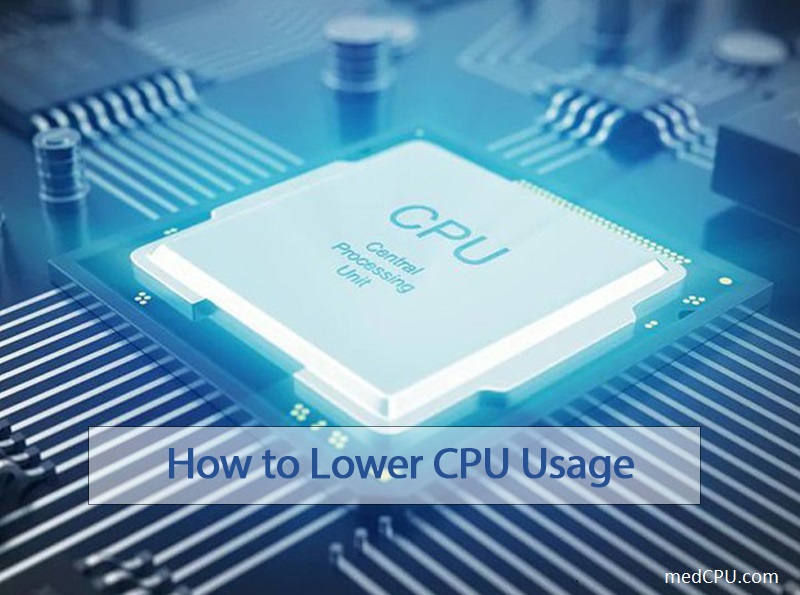Are you battling with a sluggish computer due to high CPU usage? It’s a common problem that can cause frustrating delays, unexpected shutdowns, and even damage your system over time. This blog post, medCPU will guide you through practical steps to reduce your CPU usage effectively, enhancing the overall performance of your computer.
Ready for a speedier system? Let’s dive in!
Understanding High CPU Usage
High CPU usage can be a problem that affects system performance and needs to be addressed.
Why high CPU usage is a problem
High CPU usage can be a major issue for any computer user. It leads to frustrating slowdowns and disruptive freezes, hindering productivity and efficiency. As your processor struggles under the weight of numerous tasks, it fails to perform optimally.
This scenario results in a sluggish system that takes ages to load or respond. Excessive CPU use also generates unnecessary heat which, if not properly managed, may lead to damage—a costly problem indeed!
How high CPU usage affects system performance
High CPU usage creates a significant hurdle in your computer’s performance. The heart of your system, the Central Processing Unit (CPU), manages all your computing tasks. If it is overworked or burdened with excessive processes, you are likely to experience slow response times and lagging applications.
Overloading the CPU means fewer resources are available for each program to operate efficiently. High CPU utilization often results in hardware overheating, leading to potential damage and a shorter lifespan of your device.
In extreme cases, persistently high CPU usage can result in system crashes or freezing – hindering productivity and causing frustration for users. Therefore, optimizing CPU performance not only significantly improves efficiency but also extends the life span of your computer hardware.
How to Lower CPU Usage
To lower CPU usage, start by closing unnecessary programs and processes running in the background. Updating drivers and software can also help improve system performance. Scan for malware and viruses regularly to ensure they are not causing high CPU usage.
Adjust power settings to optimize energy consumption and reduce CPU load. Finally, make sure to optimize system settings for better overall efficiency.
Close unnecessary programs and processes
Streamlining computer operations is crucial in reducing CPU usage, and a practical step towards this is closing unnecessary programs and processes that hog your system resources. It’s simple: just right-click on the taskbar, select “Task Manager,” navigate to the “Processes” tab, and take note of applications eating up significant processing power.
Select each high-usage application and hit “End Task“. But be careful! Only end tasks for programs you recognize or are certain aren’t integral to your OS running smoothly. Unexpectedly shutting down essential applications can cause system instability or crashes.
Each closed non-critical program frees up CPU resources, enhancing overall performance and efficiency over time.
Update drivers and software
To optimize your CPU performance and reduce high CPU usage, it’s important to regularly update your drivers and software. Outdated drivers can often cause conflicts and lead to increased CPU utilization.
By updating your drivers, you ensure that they are compatible with the latest hardware and software updates, allowing for smoother operation and decreased resource consumption. Similarly, keeping your software up to date ensures that any bugs or inefficiencies are addressed by developers, resulting in improved performance overall.
Regularly checking for driver and software updates is an effective way to minimize CPU usage and enhance system efficiency.
Scan for malware and viruses
One effective method to lower CPU usage is by regularly scanning your computer for malware and viruses. Malicious software can significantly impact CPU performance, causing it to run at high utilization levels.
By running a thorough scan using reputable antivirus software, you can detect and eliminate any harmful programs that may be running in the background and unnecessarily consuming your CPU resources.
This process helps optimize your system’s overall performance and reduce the strain on your CPU. Remember to keep your antivirus software up to date so that it can effectively identify and remove the latest threats, keeping your computer running smoothly.

Adjust power settings
To further optimize CPU usage and reduce strain on your system, adjusting power settings can be a helpful solution. By accessing the power options in your operating system, you can configure your computer to conserve energy and prioritize performance.
Lowering screen brightness, setting shorter sleep or idle times, and choosing a power plan that suits your needs can all contribute to minimizing CPU usage. Additionally, disabling unnecessary background processes such as Windows Update or automatic software updates can also help lower overall CPU consumption.
Fine-tuning these power settings allows for better management of resources and enhances the efficiency of your CPU without compromising its functionality.
Optimize system settings
To further lower CPU usage, optimizing system settings can make a significant difference. Start by adjusting the power settings on your computer to strike a balance between performance and energy consumption.
Lowering the screen brightness, disabling unnecessary visual effects, and setting the computer to sleep or hibernate when not in use can help conserve CPU resources. Additionally, consider tweaking system settings such as background app refresh, scheduled tasks, and automatic updates to ensure they are not unnecessarily eating up CPU cycles.
By fine-tuning these settings, you can optimize your system’s performance while minimizing CPU usage for other tasks.
Monitoring and Managing CPU Usage
To effectively monitor and manage CPU usage, use the task manager and resource monitor to identify processes that are consuming excessive resources. Keep an eye on the CPU temperature as well to ensure it doesn’t exceed safe levels.
Additionally, take control of startup programs to prevent unnecessary strain on the CPU.
Using task manager and resource monitor
To effectively monitor and manage CPU usage, you can utilize the built-in task manager and resource monitor tools in your operating system. Task Manager provides an overview of all running processes and their corresponding CPU usage.
You can access it by right-clicking on the taskbar and selecting “Task Manager.” From there, navigate to the “Processes” tab to see which programs are using up excessive CPU resources.
Resource Monitor offers a more detailed view of CPU usage and allows you to identify specific processes that may be causing high utilization. To open Resource Monitor, simply type “Resource Monitor” into the search box or find it under the Performance tab in Task Manager.
Once opened, go to the “CPU” tab for an overview of each process’s impact on your CPU performance. Keep an eye out for any applications or services that consistently have high utilization, as they might require further investigation or optimization.
Monitoring CPU temperature
To ensure optimal performance and prevent overheating, it’s important to monitor the temperature of your CPU regularly. High CPU temperatures can lead to system slowdowns and even damage your hardware over time.
To keep an eye on your CPU temperature, you can use software utilities like Core Temp or HWMonitor. These tools provide real-time temperature readings for your CPU, allowing you to identify any potential issues before they become serious problems.
By monitoring your CPU temperature, you can take proactive steps such as cleaning dust from the cooling fans or adjusting fan speeds to maintain a safe operating temperature. Keeping a close watch on your CPU temperature is essential for maintaining overall system health and ensuring smooth performance.
Managing startup programs
To further optimize CPU usage, managing startup programs is essential. When your computer boots up, it may automatically launch various applications, which can consume valuable CPU resources.
By carefully selecting the programs that start with your system, you can significantly reduce the strain on your CPU. To do this, open the Task Manager and navigate to the “Startup” tab. Here, you will find a list of all the programs that are set to launch at startup.
Disable any unnecessary applications by right-clicking on them and selecting “Disable.” Be cautious not to disable critical system processes or software required for smooth operation. By reducing the number of startup programs running in the background, you can effectively free up valuable CPU resources for more important tasks.
Conclusion
In conclusion, by following the methods outlined in this article, you can effectively lower your CPU usage and optimize your system’s performance. Close unnecessary programs and processes, update drivers and software, scan for malware and viruses, adjust power settings, and optimize system settings to minimize CPU utilization.
By monitoring and managing CPU usage using a task manager and resource monitor, as well as keeping an eye on CPU temperature, you can ensure your system runs smoothly with improved efficiency.
Take control of your CPU usage today for a better computing experience!

Eyal Ephrat serves as the co-founder and CEO of medCPU.com, where technology is making significant strides in the field of medicine. Through his experience in purchasing PC and laptop equipment and various other tech products, Eyal Ephrat contributes valuable insights to medCPU’s mission.
